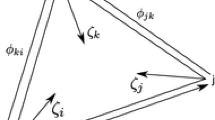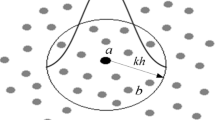Abstract
We present a new hybrid numerical method for computing the transport of a passive pollutant by a flow. The flow is modeled by the Saint-Venant system of shallow water equations and the pollutant propagation is described by a transport equation. The idea behind the new finite-volume-particle (FVP) method is to use different schemes for the flow and the pollution computations: the shallow water equations are numerically integrated using a finite-volume scheme, while the transport equation is solved by a particle method. This way the specific advantages of each scheme are utilized at the right place. This results in a significantly enhanced resolution of the computed solution
Similar content being viewed by others
References
Audusse E., and Bristeau M. (2003). Transport of pollutant in shallow water. A two time steps kinetic method. M2AN Math. Model. Numer. Anal. 37:389–416
Bale D.S., LeVeque R.J., Mitran S., and Rossmanith J.A. (2002). A wave propagation method for conservation laws and balance laws with spatially varying flux functions. SIAM J. Sci. Comput. 24:955–978
Chertock A., and Kurganov A. (2004). On a hybrid finite-volume-particle method. Submitted
Engquist B., Lötstedt P., and Sjögreen B. (1989). Nonlinear filters for efficient shock computation. Math. Comp. 52:509–537
Gallouët T., Hérard J.-M., and Seguin N. (2003). Some approximate Godunov schemes to compute shallow-water equations with topography. Comput. Fluids 32:479–513
Gerbeau J.F., and Perthame B. (2001). Derivation of viscous Saint-Venant system for laminar shallow water; numerical validation. Discrete Contin. Dyn. Syst. Ser. B 1:89–102
Gottlieb S., Shu C.-W., and Tadmor E. (2001). High order time discretization methods with the strong stability property. SIAM Rev. 43:89–112
Kurganov A., and Levy D. (2002). Central-upwind schemes for the Saint-Venant system. M2AN Math. Model. Numer. Anal. 36:397–425
Kurganov A., Noelle S., and Petrova G. (2001). Semi-discrete central-upwind scheme for hyperbolic conservation laws and Hamilton-Jacobi equations. SIAM J. Sci. Comput. 23:707–740
van Leer B. (1979). Towards the ultimate conservative difference scheme, V. A second order sequel to Godunov’s method. J. Comput. Phys. 32:101–136
Nessyahu H., and Tadmor E. (1990). Non-oscillatory central differencing for hyperbolic conservation laws. J. Comput. Phys. 87:408–463
Perthame B., and Simeoni C. (2001). A kinetic scheme for the Saint-Venant system with a source term. Calcolo 38:201–231
Raviart P.A. (1983). An analysis of particle methods. In Brezzi, F. (ed.), Numerical Methods in Fluid Dynamics, Lecture Notes in Mathematics, Vol. 1127, Springer-Verlag, pp. 243–324
Russo G. (2001). Central schemes for balance laws. Hyperbolic problems: Theory, numerics, application:Vol. II (Magdeburg, 2000), Internat. Ser. Numer. Math. 141, Birkhauser, Basel, pp. 821–829
de Saint-Venant A.J.C. (1871). Théorie du mouvement non-permanent des eaux, avec application aux crues des rivière at à l’introduction des marées dans leur lit. C.R. Acad. Sci. Paris. 73:147–154
Sweby P.K. (1984). High resolution schemes using flux limiters for hyperbolic conservation laws. SIAM J. Numer. Anal. 21:995–1011
Author information
Authors and Affiliations
Corresponding author
Rights and permissions
About this article
Cite this article
Chertock, A., Kurganov, A. & Petrova, G. Finite-Volume-Particle Methods for Models of Transport of Pollutant in Shallow Water. J Sci Comput 27, 189–199 (2006). https://doi.org/10.1007/s10915-005-9060-x
Received:
Accepted:
Published:
Issue Date:
DOI: https://doi.org/10.1007/s10915-005-9060-x




